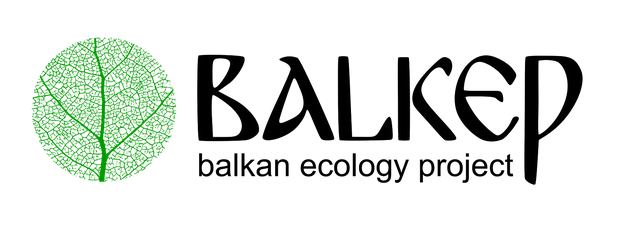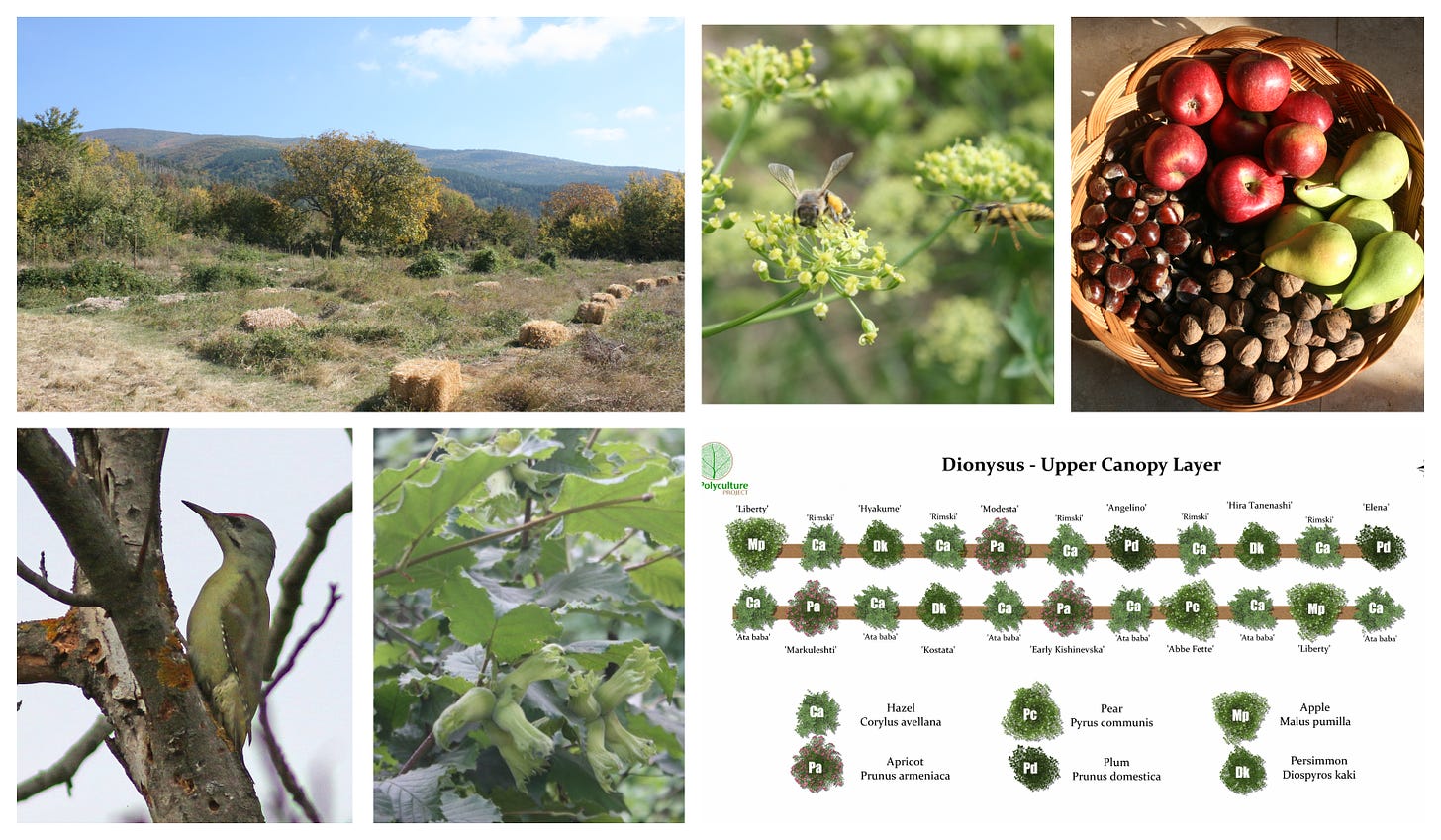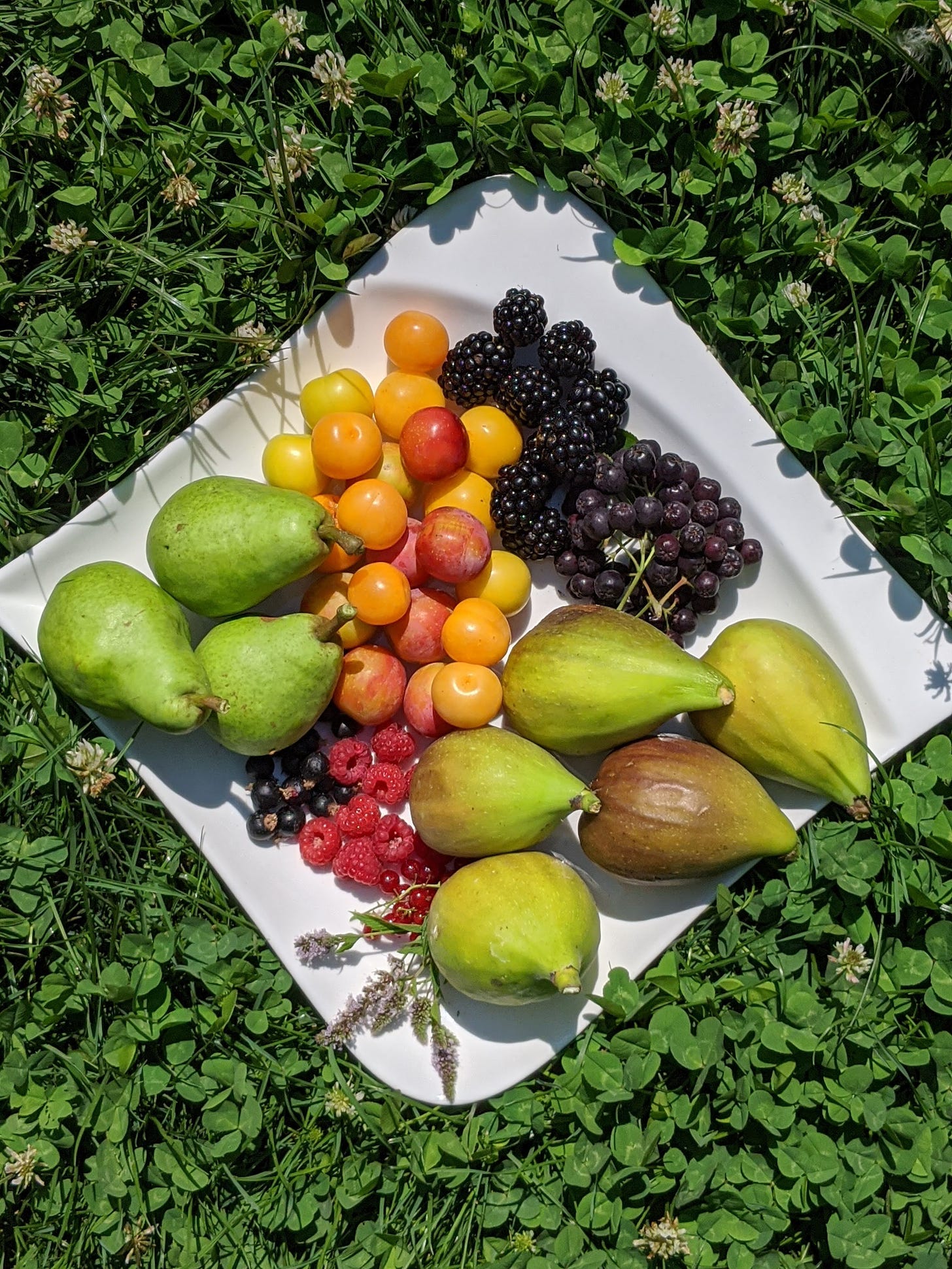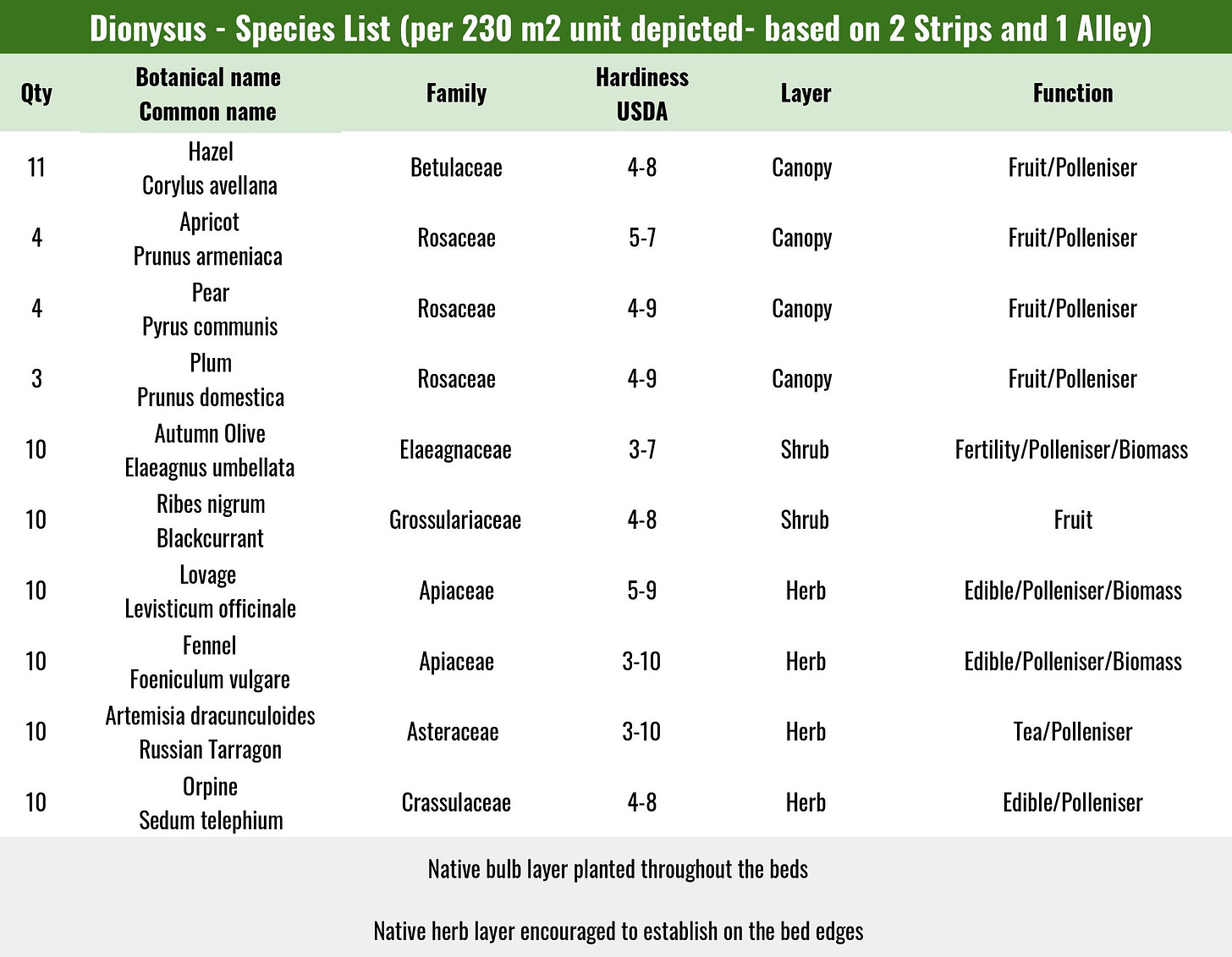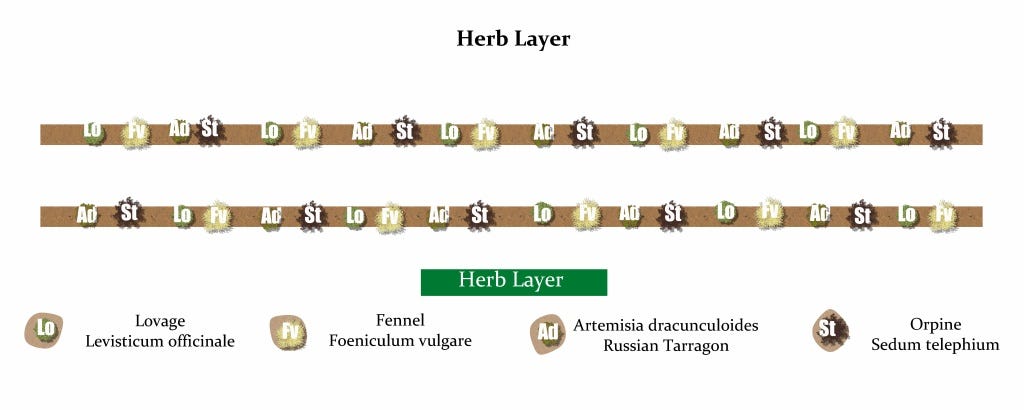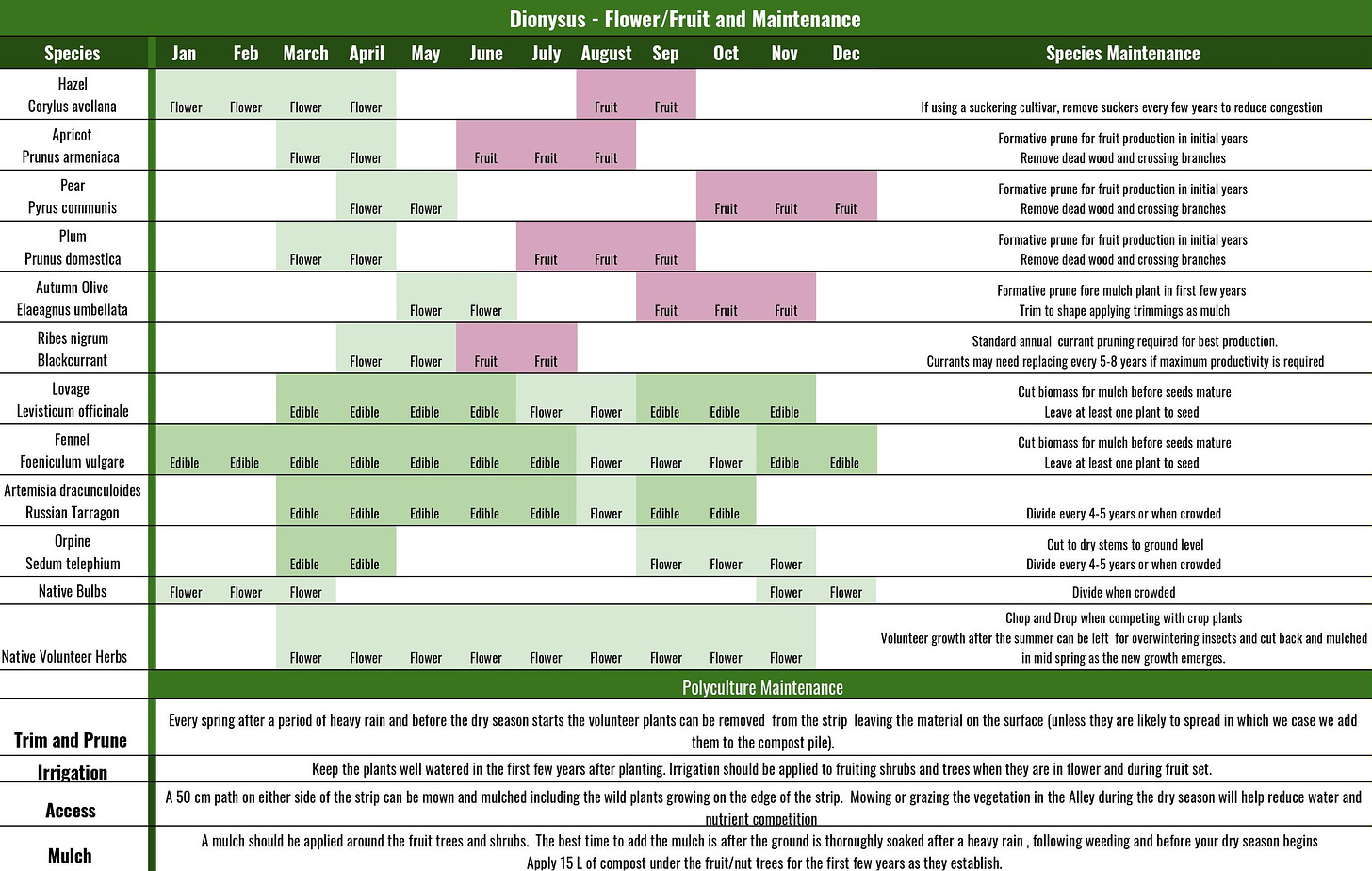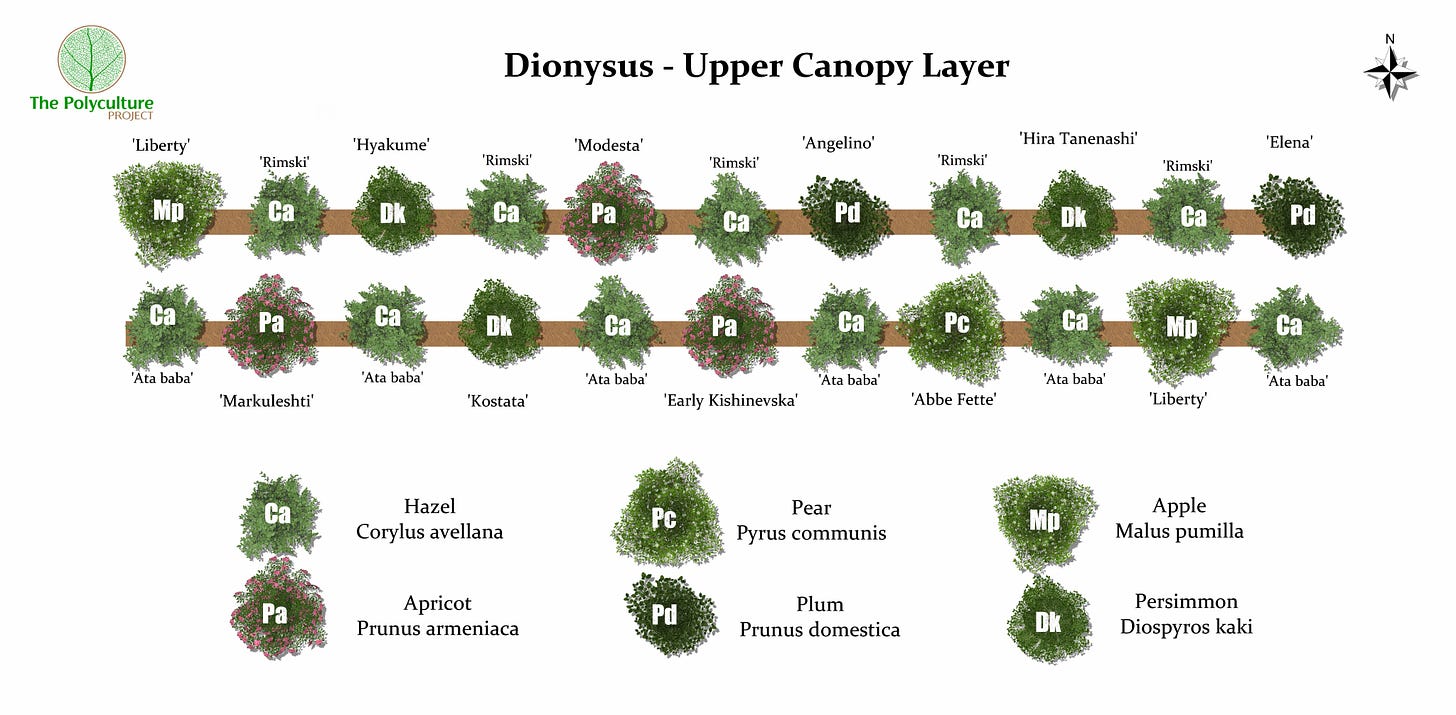Welcome to our Polyculture Profile series. During this post, we'll look at a four layer polyculture organic orchard layout that is designed to provide a succession of top fruit, berries and herbs throughout the year while attracting a range of biodiversity.
It may be helpful to look over this Polyculture Profile Layout post before or after reading the profile, where we provide a description of the profile layout and some general notes to consider, should you wish to try and grow the polyculture yourself.
Polyculture Name - Dionysus - Perennial Productive
Compatible climate:(KCC)- C - D (B with irrigation)
USDA hardiness: 5-10
Water needs: Irrigation required for optimal production
Light preferences: Full sun
Soil preferences: Light (sandy), medium (loamy) and heavy (clay)
Suitable pH: Acid, neutral and alkaline
Layout: Strip or belt
Dionysus is a four layer productive polyculture for our polyculture trial garden - Ataraxia. The purpose of the polyculture is to provide a succession of fruits and nuts for our team and to study the invertebrate associations within the herb layer. The polyculture is composed of a 1m wide bed that includes a canopy, shrub, herb and bulb layer. Between the planting beds are 3m wide alleys of mixed species meadow plants.
Overview image
The design as depicted above shows a 46m long section of two beds with one alley of grassland in between the beds, that makes up a total area of 230m2. The planting pattern is modular and can be extended vertically and horizontally to include more beds and alleys for broad scale application.
Want to learn more about Regenerative Landscape Design? Join The Bloom Room!
The Bloom Room is designed to create a space for more in-depth learning, for sharing projects and ideas, for seeking advice and discovering opportunities.
Ultimately, it aims to build a more intimate, interactive, and actionable relationship between members, a way for the Bloom Room community to support each other’s projects and learning journeys, and to encourage and facilitate the design, build, and management of more regenerative landscapes across our planet.
What you can expect as a member of the Bloom Room
As a member of the Bloom Room you can expect;
Access to an interactive forum where you can ask questions, direct what type of content you would like to see as well as share your own content and projects.
Monthly live session featuring general Q&A and tutorials on design software for creating and presenting polycultures.
Live session every month for members to showcase your projects, plans, designs, and gardens, with guest speakers from the community.
Full Access to all of the content on Substack
A 50% discounts on all of our online courses
Future opportunities to join our Global Regenerative Landscape Design and Consultancy Service, with potential roles for those with the will and skill to join our design team.
An opportunity to take part in the group ownership of a Regenerative Landscape. You will find more details on that here.
Become a paid subscriber to our Substack to join. The annual subscription is currently $70 and the monthly subscription is $7 (monthly subscription excludes discounts for products and services) . You can join here, we look forward to meeting you!
Access to an interactive forum where you can ask questions, direct what type of content you would like to see as well as share your own content and projects.
Monthly live session featuring general Q&A and tutorials on design software for creating and presenting polycultures.
Live session every month for members to showcase your projects, plans, designs, and gardens, with guest speakers from the community.
Full Access to all of the content on Substack
A 50% discounts on all of our online courses
Future opportunities to join our Global Regenerative Landscape Design and Consultancy Service, with potential roles for those with the will and skill to join our design team.
An opportunity to take part in the group ownership of a Regenerative Landscape. You will find more details on that here.
Functional components
The polyculture consists of four layers including a canopy of fruit and nut trees, apricot, pear, plum and hazel, a shrub layer with blackcurrant and Elaeagnus nitrogen fixer, a herb layer of edible plants that attract a wide range of beneficial insects namely lovage - Levisticum officinale, orpine - Sedem telephium and fennel - Foeniculum vulgare. The bulb layer consists of native bulbs.
Production potential
A range of fruit, nuts, berries and herbs can be harvested from the polyculture throughout the year. See harvest calendar below.
Habitat potential
Succession of flowering plants along with the diversity of layers provide excellent habitat to a range of wildlife, including Borgs. If planted at scale, a number of habitat features such as rock piles and small wildlife ponds can be included in the strip to encourage yet more Borgs to the polyculture.
Fertility/biomass potential
The autumn olive - Elaeagnus umbellata plants are the main biomass producers in this polyculture and once established can be trimmed annually to a 80cm wide and 1m tall shrub, with the arisings left on the bed to decompose. The native bulb layer planted under the trees and shrubs should assist nutrient retention and cycling in the soil, as will mowing and mulching the volunteer plants that grow on the edges of the beds. The growth in the alley can also be used for supplying mulch for the fruit and nut trees.
Access
All areas of the bed can be accessed from the alleys. If implemented at scale a lightweight compact utility tractor with a trailer is best used within the alleys for harvesting and maintenance tasks.
Species list
I have not listed the ground cover alley species or the native bulbs. I have not listed the fruit cultivars names here but you can find the cultivars we planted in the illustration at the bottom of the page. The best cultivars to use are ones that are well adapted to your climate and have a history of growing in your region without pest and disease issues.
Regenerative Landscape Design - Online Interactive Course
Want to learn how to design, build and manage regenerative landscapes? Join us on our Regenerative Landscape Design - Online Interactive Course. We look forward to providing you with the confidence, inspiration, and opportunity to design, build and manage regenerative landscapes, gardens, and farms that produce food and other resources for humans while enhancing biodiversity.
You can find the course details here and at the moment we have a $350 ( 20%) discount for full enrollment to the course. Just use RLD2024 in the promo code section of the registration form to receive your discount.
Planting
The planting distance the plants can be seen below with this pattern repeating along the strip. Canopy tree, herb, shrub, herb, canopy Tree and so on.
Layer by layer
Diagram of each layer showing the placement of plants.
Polyculture succession
In the first three or four years of growth the light available in the alleys will be suitable for growing a range of plants. As the fruit trees in the bed develop wider crowns the available light will diminish and at maturity the canopies of the trees will almost be touching. The choice of alley crops or vegetation will therefore adapt over time to include shade tolerant plants.
Flower/fruit and maintenance
Fruit and nut cultivars
Cross pollination is desirable to achieve the optimal yields in an orchard and selecting compatible cultivars is an important part of the design. Below is a list of the cultivars selected for Dionysus. To learn more about fruit and nut pollination and how to select the right species and cultivars see our post here.
Support Our Project
If you appreciate the work we are doing you can show your support in several ways.
Become a member of the Bloom Room. A $70 annual or $7 per month subscription to our Substack provides you with access to live sessions, design tutorials, a members forum and more, see details here.
Make a purchase of plants or seeds from our Nursery or Online Store
Joining us for one of our Practical Courses or Online Courses
Comment, like, and share our content on social media.
If you appreciate the work we are doing you can show your support in several ways.
Become a member of the Bloom Room. A $70 annual or $7 per month subscription to our Substack provides you with access to live sessions, design tutorials, a members forum and more, see details here.
Make a purchase of plants or seeds from our Nursery or Online Store
Joining us for one of our Practical Courses or Online Courses
Comment, like, and share our content on social media.
We offer a diversity of plants and seeds for permaculture, forest gardens, and regenerative landscapes including a range of fruit and nut cultivars. We Deliver all over Europe from Nov - March. - Give a happy plant a happy home :)
Welcome to our Online Store where you can find Forest Garden/ Permaculture plants, seeds, bulbs, and Polyculture multi-packs along with digital goods and services such as Online Courses, Webinars and eBooks. We hope you enjoy the store and find something you like. It's your purchases that keep our Project going.
You can also find our full list of trees. shrubs and herbs for forest gardens on our nursery website.
